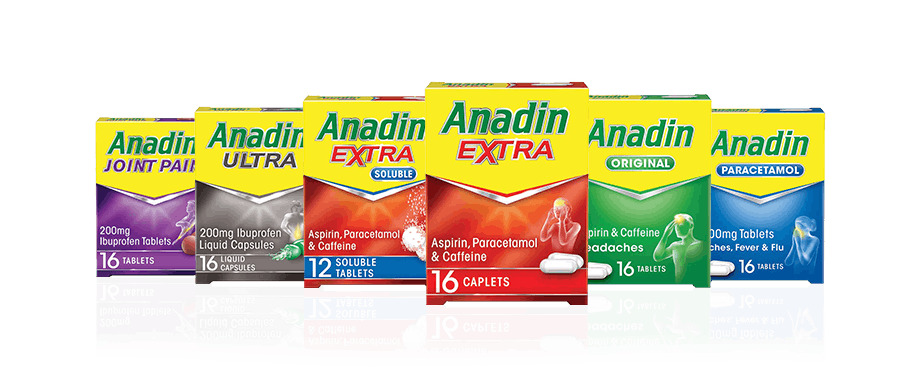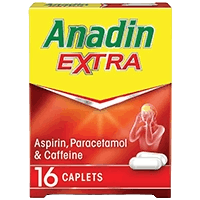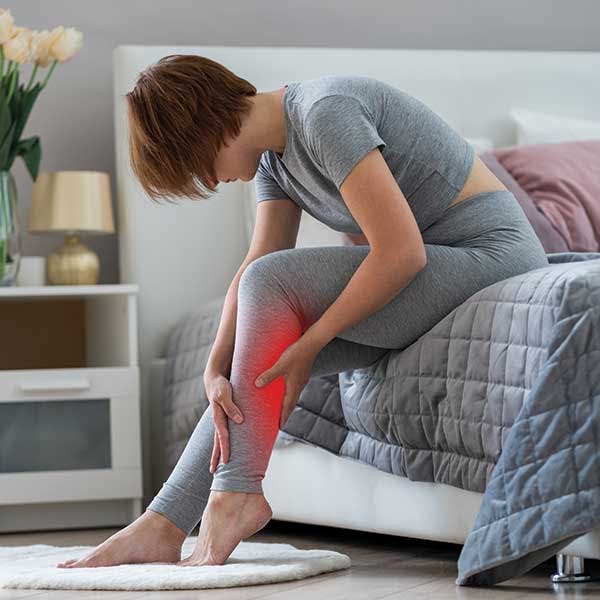Aspirin + Caffeine
Aspirin + Paracetamol + Caffeine
Anadin Extra Tablets Anadin Extra Soluble Tablets
Paracetamol
What is Back Pain?
Back and muscle pain is a very common condition amongst adults and is in fact one of the main reasons people visit their doctor and take sick leave from work. Most people will experience back and muscle pain at some point throughout their lives, particularly in the lower back (lumbago) as this is a particularly common area.
Back pain can be a shooting, burning or stabbing sensation. In addition, the pain may radiate down your leg or worsen with bending, twisting, lifting, standing, or walking.

Back Pain Causes
What Causes Back Pain?
It can be very difficult to identify the specific cause of back pain. Back pain can sometimes result from an injury/accident but often it can develop for no apparent reason or slowly over a number of years as we age.
Lifestyle Risk Factors
- Age – back pain is more common as you get older
- Poor posture
- Lack of exercise – weak, unused muscles in your back and abdomen might lead to back pain
- Excess weight – puts extra strain on your back
- Incorrect lifting – using your back instead of your legs can lead to back pain
- Smoking – smokers have increased rates of back pain. This may occur because smoking prompts more coughing, which can lead to herniated disk
Health Conditions
- Osteoporosis. Your spine's vertebrae can develop painful fractures if your bones become porous and brittle.
- Arthritis. Sometimes, arthritis in the spine can lead to a narrowing of the space around the spinal cord, a condition called spinal stenosis.
- Sciatica. An irritation of the nerve that runs from the pelvis to the feet, which causes pain in your back and legs.
- A slipped disc. Happens when a disc of cartilage in your spine presses against a nearby nerve.
What Causes a Back Strain or Sprain?
A back strain or sprain (also known as pulling a muscle) can be caused by repeated heavy lifting or a sudden awkward movement that strains your back muscles and spinal ligaments. Constant strain on your back can cause painful muscle spasms, especially if you’re in poor physical condition.
A sprain often occurs after a fall or sudden twist, or a blow to the body that forces a joint out of its normal position. All these conditions stretch one or more ligaments beyond their normal range of movement, causing injury.
Additional causes include:
- Excess weight
- Curving the lower back excessively
- Having a weak back
Back Pain Symptoms
Unfortunately, there are no advance symptoms that tell you when your back pain is about to start, it’s typically an immediate pain that feels like stabbing or a shooting pain. Muscle pain symptoms include:
- Intense stabbing or shooting sensation
- Sharp pains in one or both of your legs
- Walking or standing becomes impaired
Types of Lower Back Pain
There are three types of lower back pain, these include:
- Non-specific muscular pain. Otherwise known as a muscle strain. This is the most common type of lower back pain, which involves intense muscular pain in one or both sides of your lower back. Often caused by lifting, stretching or anything that causes stress to the lower back.
- Muscle spasms. These occur when the back muscles involuntary contract. Usually caused by bending, heavy lifting and other physical activities.
- Radicular pain. This involves sharp, shooting pain that starts in the back and travels to one or both legs. Often caused by degeneration of the spinal disc or pinching of one or more nerve roots.
Back Pain Treatment, Management and Relief
One of the most effective means of back muscle pain relief is exercise. Exercises that strengthen core or abdominal muscles may help to speed up your recovery from back pain. There are many types of exercise that can help with back pain including swimming, walking, yoga, pilates and going to the gym.
Physiotherapy can be useful to improve your strength and flexibility. A physiotherapist can help oversee your exercise programme and recommend specific exercises for treating lower back pain. Occupational therapy is ideal if your back pain is causing you problems with everyday life. It can help you modify your activities to reduce the strain on your back.
Back pain, especially if it lasts a long time, can affect people’s mood. If you are feeling low or anxious, it’s important to talk to someone about it. Talking therapy (such as cognitive behaviour therapy, CBT) can be useful.
Furthermore, over the counter pain medication such as Anadin Ultra gets to work up to 2x faster than standard ibuprofen tablets.*
*based on absorption data for a 400mg dose.
Yoga Poses for Back Pain Relief
Research has found that yoga can significantly help people with lower back muscle pain lead more active lives and manage their condition more effectively. It can also help you understand how to prevent future attacks. Don’t expect immediate results, it may take time for your body to respond. As with everything in life, the more you put into it, the more you will get out of it.
Recommended yoga poses for back pain:
- Downward-facing dog
- Upward-facing dog
- Child’s pose
- Cat and cow pose
- Triangle pose
- Chair pose
- Pigeon pose
Back pain usually gets better on its own within a few weeks or months and you may not need to see a doctor or other healthcare professional. But it’s a good idea to get help if:
- The pain does not start to improve within a few weeks
- The pain stops you doing your day-to-day activities
- The pain is very severe or gets worse over time
- You’re worried about the pain or struggling to cope
You should contact a GP or NHS 111 immediately if you have back pain and:
- Numbness and tingling around your genitals or buttocks
- Difficulty peeing, loss of bladder or bowel control – peeing or pooing yourself
- Chest pain
- A high temperature
- Unintentional weight loss
- A swelling or deformity in your back
- It does not improve after resting or is worse at night
- It started after a serious accident, such as after a car accident
- The pain is so bad you’re having problems sleeping
- Pain is made worse when sneezing, coughing or pooing
- The pain is coming from the top of your back, between your shoulders, rather than your lower back
These problems could be a sign of something more serious and need to be checked urgently.











